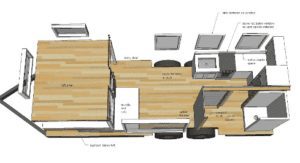Day 47: Tiny House Living
Dear Student,
The whole tiny house movement seemed like a quirky fad when it first got an online following in the early 2000s, but since then the interest in the counter culture of “living small” has continued to grow. There are more and more television shows and websites dedicated to those who want to build or buy their own tiny home.
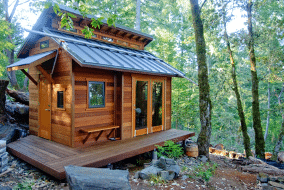 Some people put tiny homes to use as home offices in their backyard… Others see a tiny house as a quick and easy way to create additional guest accommodation for their home that looks cute and makes for an interesting talking point… Some have a tiny cottage as their weekend getaway out of the city as a more comfortable alternative to camping.
Some people put tiny homes to use as home offices in their backyard… Others see a tiny house as a quick and easy way to create additional guest accommodation for their home that looks cute and makes for an interesting talking point… Some have a tiny cottage as their weekend getaway out of the city as a more comfortable alternative to camping.
However, more and more, people are choosing to leave their consumerism-driven lives behind and downsize into a tiny home as their full-time residence.
There are advantages and disadvantages to making such a life-changing decision like this, and indeed, that is its largest attraction for enthusiasts: It is a drastic, life-changing decision.
The modern, materialistic lifestyle has seen the size of an average house in the United States nearly triple in since the late 1950s, while the number of people living in them has dropped dramatically in the same time.
This need for bigger homes that hold fewer people doesn’t seem to make sense. You’d imagine the only sane reason for this would be that the average U.S. household is making more money in relative terms and could afford all this extra space.
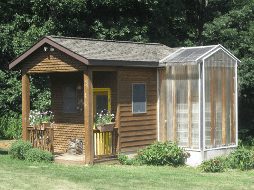 But, as we all know, this is not the case.
But, as we all know, this is not the case.
Since the 50s, the average debt per household (totally and as a proportion of income) has skyrocketed. U.S. households now have the highest income-to-debt ratios in U.S. history—the largest culprits being credit card debt and home mortgage debt.
Why are U.S. citizens buying bigger homes that they can’t afford and running up massive credit card bills buying stuff to fill them?
It’s a phenomenon that really didn’t exist 60 years ago, but one that we are all familiar with today: consumerism.
We are working longer hours to buy things we don’t need and can’t afford to fill spaces in our homes that we don’t use. We believe a bigger home, more clothes, and more furniture, and more more more will make us happy. Is the average U.S. citizen more content than he was 50 years ago? You know they aren’t. Research shows the opposite, in fact.
The tiny house movement offers an alternative to this more-is-more mentality. It allows many to get out of debt and own their own home, offering a sense of security and insulating them from the shocks of a volatile economy. The bank can’t take your house if you have no mortgage.
Of course, there are drawbacks. And this is a somewhat extreme downsize, so let’s look at some of the pros and cons…
What Is A Tiny House?
While there is no set-in-stone definition, the general consensus is that a tiny house is less than 500 square feet in size, and many would argue it really means less than 400 square feet. Under this general umbrella is a sub-category of micro homes—houses of less than 150 square feet.
These houses are designed for maximum efficiency on the inside—not a square inch can go to waste. Designing in this manner, as the Japanese and Nordic countries have been doing for decades and even centuries, allows more functionality per square foot compared to giant McMansions, with their huge amounts of wasted space.
Figure 1 – Copyright: http://www.ana-white.com/
A strange consequence of the wasted space in these McMansions: Owners feel the need to fill all the empty spaces with more furniture and stuff, driving them deeper into debt.
Tiny houses of less than 300 square feet are often built on trailers so that they can be towed to a new location if the owner’s job moves. Some are even brought on vacation like a motor home—no hotel fees!
Pros
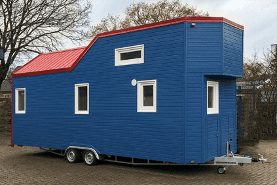 Tiny houses can cost a fraction of what a conventional home costs, often allowing the owner to build one and own it outright. This means no rent or mortgage. Imagine how quickly your other debts could be paid off if you didn’t have these massive monthly payments hanging over your head. Once your debts are paid off, you can start saving for a larger home and buy it with cash upfront if that’s your goal.
Tiny houses can cost a fraction of what a conventional home costs, often allowing the owner to build one and own it outright. This means no rent or mortgage. Imagine how quickly your other debts could be paid off if you didn’t have these massive monthly payments hanging over your head. Once your debts are paid off, you can start saving for a larger home and buy it with cash upfront if that’s your goal.
- The majority of tiny houses are mobile, so you can bring your home with you wherever you go.If you move you won’t have any relocation fees. Won’t have to deal with selling your home, paying brokers’ commissions, being held hostage to volatile real estate prices, or needing to find a new home.You could even vacation with your tiny home if going within driving distance, saving on hotels and food costs.
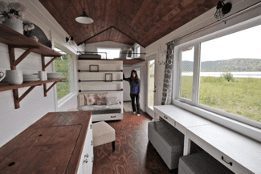 They can be extremely environmentally friendly and can often be made partly or totally from recycled or salvaged materials.
They can be extremely environmentally friendly and can often be made partly or totally from recycled or salvaged materials.- They can be extremely energy efficient: Heating and cooling a tiny space is cheap!
- You can declutter your life. In fact, your space restrictions mean you will likely have to…
- Spend less time and money cleaning. There is only a fraction of the space to clean, you can do it yourself—using less cleaning products; you’ll never need a maid.
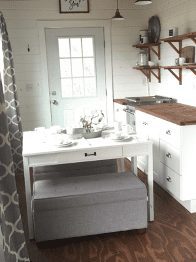
- These houses are compact and can be very cozy, you also don’t spend any time going from the kitchen to the dining room, and eventually off to bed. Everything is within a dozen paces of each other. For those with motility limitations, a tiny home is the ultimate solution.
- Lower carbon footprint.
Cons
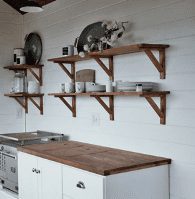
- Tiny houses can be tough on relationships—especially if you don’t get along very well already—as privacy is an issue. You can’t sleep in the guest room after a fight… can’t hide in the second living room to watch your own TV show…
- If you love being a host, you’ll lose out on this aspect of life in a tiny house. It’s difficult to entertain more than a few people in them… you might have to resign yourself to al fresco dinner parties in fine weather.
- Space is precious and, even after uncluttering your life, there might be items you want but can’t fit in your home.
Is It Really Feasible?
Can you really live a comfortable life in a tiny house?
Many can and do.
The question is: Will you be happy in this kind of residence?
It’s a highly personal decision and a big change. Many can’t fathom living in such a small space… but if you want to make the adjustment—and it will be an adjustment, be honest with yourself—you will adapt, I promise.
Thanks to Ana White for her permission to use the images in this lesson of what tiny house living can actually look like. The floorplan and interior pictures I’ve put here are of a 200-square-foot tiny home. As you can see, there is much more to this small space than one expects in 200 square feet. This unit sleeps up to three couples, with a main bedroom, the roll-away bed, and loft space.
Note especially the sleeping loft (below) that allows for an additional sleeping/storage area to be positioned over the main bedroom (behind the trundle bed). The sliding trundle bed can be pulled out for extra sitting or sleeping space when needed and easily rolled away when it’s not needed to free up the space.
The Tiny Bottom Line…
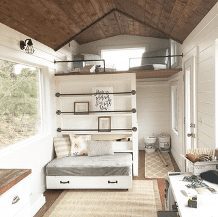 These are low cost, innovative, and practical options for people who would like to quickly own their own home and stop paying mortgages and rent… forever.
These are low cost, innovative, and practical options for people who would like to quickly own their own home and stop paying mortgages and rent… forever.
The tiny house route can be liberating, creative, and fun, but it does come with compromises. Living in a small space requires some patience, and you will soon have to become extremely organized (if you aren’t already).

